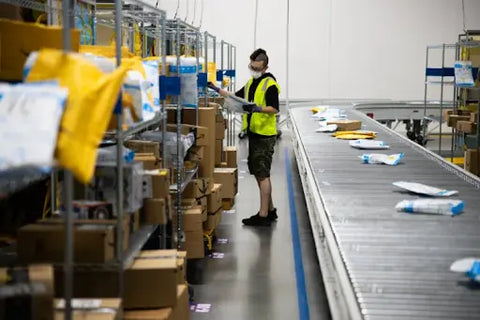Amazon has one of the most efficient and sophisticated supply chains in the world. It supports fast delivery and customer satisfaction to its best. Thus, it clearly reflects the vision of the company. From sourcing the products to delivery there are many steps involved in the supply chain.
So, in this article, we will explore how Amazon's supply chain works and other aspects of the supply chain.
Key Components of Amazon's Supply Chain
The core components of Amazon's supply chain are:
- Sourcing and procurement
- Inventory management
- warehousing and fulfillment
- Last-mile delivery
Each of these components is planned meticulously allowing Amazon to deliver products globally quickly and reliably. Especially if you wonder how does Amazon Prime Day works for supply chain coordination, then you will see below how all core components of Amazon’s supply chain work to ensure the demands for Prime Day.
Sourcing and Procurement
Amazon sources products from all over the world. These sources are both large corporations and small third-party sellers. These sellers aim to reach a broader market through Amazon.
There are two primary methods through which Amazon sources its products:
-
Direct Sourcing
Amazon directly purchases the products from manufacturers and store them in its warehouses. From there they are sold to customers.
-
Marketplace Model
In this model, third-party sellers list their products on Amazon. From where they have the option to handle their fulfilment on their own. Or they can leverage the Amazon warehousing and logistics capabilities using Amazon FBA service.
Such sourcing models allow the company to offer a wide variety of products. From daily-use essentials to special items, consumers can find all kinds of products on a single platform.
Inventory Management
Effective inventory management allows the products to be available to customers all the time. Through Amazon’s advanced algorithms and data analytics, they monitor and forecast demand. This helps the company maintain its inventory all the time.
Key aspects of Amazon’s inventory management include:
Demand Forecasting
It is based on historical sales data, seasonality, and other factors to predict future demand. It satisfies the issue of excess inventory and meets customer’s needs in exact numbers.
Automated Replenishment
Amazon has a certain threshold and it uses automated systems to reorder products when inventory levels fall from the threshold. It maintains steady stock levels and reduces the risk of stockouts.
Inventory Distribution
Amazon has a vast network of fulfilment centers. It allows faster delivery times due to the strategic distribution of inventory. Amazon reduces shipping distances and costs by keeping popular items closer to high-demand areas.
Warehousing and Fulfillment

This is the heart of Amazon’s supply chain. The company has a massive network of fulfilment centers around the world. Each center is equipped with cutting-edge technology to handle, store, and ship products efficiently.
Three main types of these fulfillment centers are:
-
Sortable Fulfillment Centers
They are large warehouses where products are sorted, packaged, and shipped. Robotic systems like Kiva robots are used to transport shelves of products to human workers. Then these workers pick, pack, and prepare them for shipping.
-
Non-Sortable Fulfillment Centers
These centers typically handle larger or heavier items, such as furniture and appliances. No robotic systems are used in these centers due to their size and weight.
-
Specialized Fulfillment Centers
There are other centers like Prime Now hubs for same-day delivery and Fresh fulfillment centers for grocery items. They are located at places that ensure quick delivery for time-sensitive products.
Amazon’s fulfillment process is mostly automated. As an order is placed, robots find the desired product in the warehouse and transport it to the packing station. From there the order is packed, labeled, and sent to a sorting facility. There it is organized based on its final destination.
Last-Mile Delivery
It is the final step in Amazon’s supply chain and the most important one. It involves transporting the product from a local distribution center to the customer’s doorstep. Some of the methods Amazon used to ensure fast and reliable last-mile delivery:
Amazon Delivery Service Partners (DSPs)
Amazon collaborates with various delivery companies which handle a significant portion of last-mile deliveries.
-
Amazon Flex
It’s a program where a person can get affiliated with Amazon to deliver its products on their personal vehicles. It provides flexibility to Amazon, especially during peak periods
-
Amazon Prime Air

For long-distance urgent shipments, Amazon uses a network of Prime Air planes. They transport packages between major hubs.
-
Amazon’s Drone Delivery Program
This program is still in the testing phase. But once active this program will allow the delivery of small packages within 30 minutes or less. This program would revolutionize the delivery programs, making deliveries easy and effective in suburban and rural areas.
Amazon has a logistic network that manages the company’s transportation fleet. As Amazon owns much of its delivery infrastructure it can maintain better control over delivery times and costs. This improves the customers’ experience on Amazon.
Sustainability Efforts in Amazon's Supply Chain
Amazon seriously worked its way towards making its supply chain environmentally effective. With setting ambitious goals like achieving net-zero carbon emissions by 2040. Some of Amazon’s initiatives include:
-
Electric Delivery Vehicles
Amazon has invested in electric delivery vehicles to reduce carbon emissions in their last-mile delivery.
-
Solar-Powered Fulfillment Centers
Most of Amazon’s fulfillment centers use solar energy as it’s a renewable energy source.
-
Packaging Optimization
Amazon uses machine learning to optimize packaging sizes. It reduces waste and minimizes the environmental impact of shipments.
Conclusion
Amazon's supply chain uses technology, automation, and strategic logistics to streamline the chain operations. It controls all the aspects of its supply chain to meet customer demands quickly and reliably. Amazon is still working to enhance its ability to deliver products faster and more sustainably.
FAQs
How does Amazon's supply chain work?
Amazon's supply chain involves many steps but the key operations involve sourcing and procurement, inventory management, warehousing and fulfillment, and last-minute delivery.
How does Amazon Prime Day work for supply chain coordination?
Amazon relies on inventory management to handle the increase in demand on Prime Day. It works closely with suppliers to ensure the availability and timely delivery of products.


